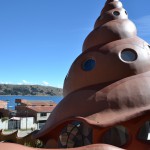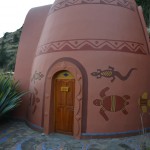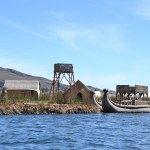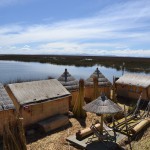From Uyuni, we took a flight to La Paz, where we spent about one day only. Since we had some concerns around safety, and the city didn’t seem to offer very much in terms of sights, we didn’t do much there, except for walking around through the city center along the main axis, the Prado, for a bit. The one highlight was finding a German bakery – apparently Bolivia has quite a sizable population of German heritage.
The next day, we left via bus for Copacabana on the shores of Lake Titicaca. We had booked a bus ticket with Bolivia Hop, which operates a hop-on/hop-off bus service all the way through to Cusco in Peru, and in contrast to many Bolivian operators they cater to tourists and are extremely professional and service oriented.
Copacabana is a tiny, relatively touristy town. It has the only public beach in landlocked Bolivia, but since it was obviously winter and quite cold, nobody was using the hundreds of small swan-shaped pedal boats that you could rent there. We stayed at Hostal Las Olas, which is definitely the most unique hostel I have ever seen. The rooms are in little huts with different shapes – there is a snail, a tower, etc., all beautifully painted in a terraced garden that even had some grazing llamas. Our room was called the turtle, and was a round two-story building, with a huge round bed at the center of the lower floor, and a small wood oven that we were able to use to heat the room. We were also able to find some really good breakfast food (eggs!) and coffee in Copacabana, at the little cafe “El Condor and the Eagle” – run by an Irish-Bolivian couple. Otherwise, we mostly relaxed for the one day we were there, since there was not that much to do.
The next day, before leaving by bus for Peru, we did a quick boat tour to Isla Del Sol, the biggest island on Lake Titicaca. The Incas believed that this was were the sun was born, and we visit see a small Insa temple on the island as well. Unfortunately, we had very little time on the island since we needed to catch our bus to Peru.
After crossing the border, which was hassle-free but took about an hour since very one on the bus had to clear immigration before we could continue, we continued to the town of Puno on the Peruvian shore of Lake Titicaca, where we had a hotel for one night. Puno is quite a big town, no comparison with Copacabana, but doesn’t offer much in terms of sights, so some people we spoke with on the bus had said there was nothing to do. However, we did enjoy walking around town and getting some food that was definitely much better than most things we had eaten in Bolivia.
The next morning, we left for the floating island of Uros Khantati, where we were going to spend one night. Uros Khantati is part of Las Uros, a “village” on Lake Titicaca made up entirely of floating islands constructed from the Totora reeds that grow on the lake. When exactly the Uros inhabitants decided to live on the lake is unclear (there are no written records), but oral transmission has it that they fled either the Incas or the Spanish conquistadors. Initially, they just lived on reed boats with houses on them, but eventually started building larger platforms like the one we stayed on, which was probably about 30 by 30 meters, with roughly ten small houses on it. The hosts, Cristina and Victor, have been running this home stay for some years now and were the first to offer accommodation on one of these islands to foreigners.
We didn’t just stay on the island, however: Victor also took us (and a few other tourists who were also spending the night) out on the reed boat to demonstrate fishing and reed cutting techniques (both to use the reed for construction, and to get to the edible root, also called “Titicaca Banana”), and Cristina showed us traditional attire which we were also able to try on and take pictures in. All in all, it was a great experience – of course still catering to tourists, but much less of a tourist trap than the short tours of Las Uros than you can book via a tour agency. Plus, our hosts were both friendly and entrepreneurial, which should be supported!
We left Uros Khantati the next day and spent another day in Puno before continuing to Cuzco.
Some pictures follow.
- Hostal Las Olas
- Hostal Las Olas
- Uros
- Uros
- Uros




